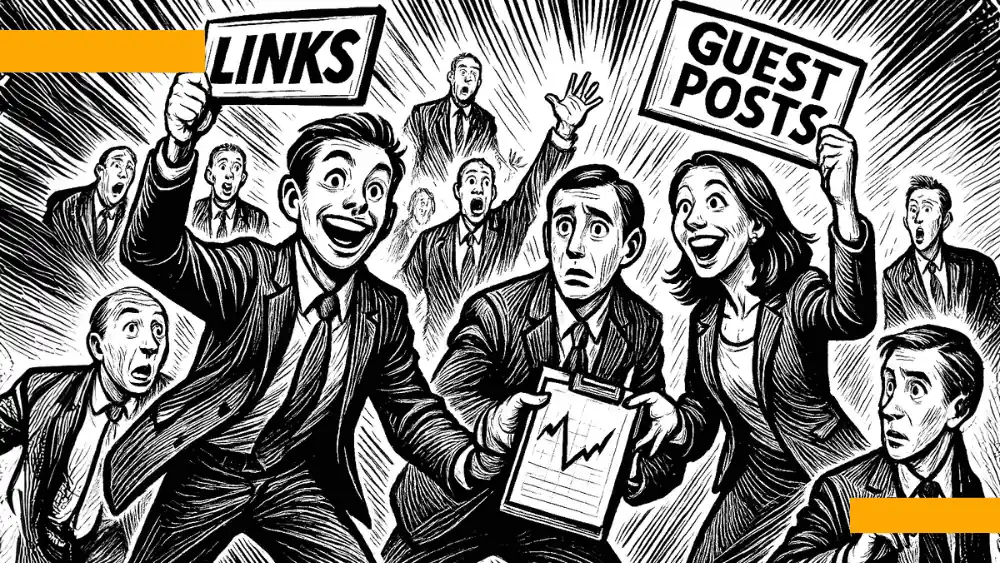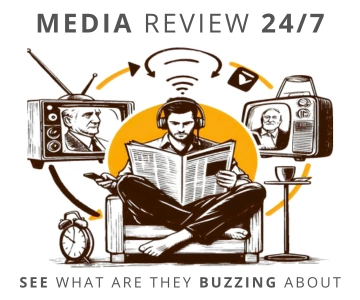 illustration: DALL-E
illustration: DALL-EThe Adsy team analyzed 37,542 websites to find out what guest posts really cost. This wasn`t dry statistics. The authors of the report "How Much Should You Pay for a Guest Post?" compared data from thousands of actual offers, examining how traffic, domain authority, industry, and country affect prices. The results reveal massive gaps between what publishers ask and what buyers actually pay.
The higher the DR, the higher the price
The report shows that the main factor influencing the price of a guest post is Domain Rating (DR), a metric of domain authority by Ahrefs. Sites with DR 1-10 offer posts for an average of $238. When DR goes above 70, prices skyrocket.
| Domain DR | Average guest post price ($) |
|---|---|
| 11-20 | 351 |
| 41-50 | 462 |
| 71-80 | 1008 |
| 81-90 | 1371 |
| 91-94 | 4530 |
Two key jump points emerge: passing DR 10 and entering the 70+ range. Why? Sites with DR above 70 are viewed as top-tier link sources. Major investments go into them, directly influencing publication costs.
Traffic matters too, but less
In theory, more organic traffic should mean a more valuable site and pricier guest posts. In practice, user numbers matter less than many marketers assumed. Adsy shows that while differences between sites with 1K, 5K, and 10K visits exist, they’re not as big as those driven by DR changes.
The sharpest price increase happens when moving from 1K to 5K monthly users. For DR 11-20 sites, average prices jump nearly 30%. But going from 5K to 10K only adds another 11.6%. This suggests the turning point is when a site becomes “alive” with real, steady traffic - more so than with ongoing growth.
Adsy’s team notes that sites with under 1K traffic are often shell sites, PBNs, or empty domains with little real content. Guest posts there are the cheapest and offer limited SEO value. Crossing the 5K mark boosts trust. But after 10K users, link value doesn`t rise as steeply - perhaps because Google algorithms prioritize authority over just traffic.
Average guest post price increases with rising traffic:
- 1K → 5K: +17% on average
- 5K → 10K: +7.2% on average
- Biggest jump: DR 11-20, from 1K → 10K traffic: +43%
- Smallest rise: DR 21-30, from 5K → 10K: just +3.2%
This shows that while traffic affects price, it’s not the key quality indicator. Buyers want sites that not only attract users but also have strong link profiles and stable rankings. That’s why DR stays the dominant factor in guest post pricing.
The market says: sellers want too much
The most shocking takeaway from the report is the gap between average sale prices and average purchase prices for guest posts. The difference isn’t just 2x or 3x - in high DR cases it can reach 14x. This means the average purchase price is just a fraction of the offer price, throwing the link-building market off balance.
| DR | Avg. sale price ($) | Avg. purchase price ($) |
|---|---|---|
| 41-50 | 406 | 59 |
| 71-80 | 941 | 199 |
| 90-92 | 4595 | 318 |
This reveals how overpriced the market really is. Sellers base their rates on the theoretical SEO value a link might bring but ignore buyers` budget realities. As a result, the market runs on constant negotiation and markdowns. The average transaction price makes one thing clear: most buyers reject list prices and actively seek cheaper options or push for discounts.
Industry and country. Who sets the guest post prices?
Price differences between industries are as sharp as between countries. According to Adsy, the cheapest niches have low commercial value or too much supply. On the flip side are sectors with high demand and big marketing budgets. Web development tops the list, with an average guest post cost of $1096. By contrast, a personal blog post costs just $323.
It’s not only about niche popularity. Journalism, though common, is one of the cheapest sectors. Many sites in these categories are mass-produced and lack high authority or quality. For example, personal blogs, public administration, locations, and e-commerce sit in the $300-350 range. Their low value stems from high competition and limited SEO priority from owners.
| Cheapest industries | Avg. price ($) | Most expensive industries | Avg. price ($) |
|---|---|---|---|
| Public Administration | 306 | Web Development | 1096 |
| Personal Blogs | 323 | Literature | 849 |
| E-commerce | 354 | Beauty | 813 |
| Startups | 380 | Manufacturing | 808 |
Meanwhile, industries like literature, beauty, and manufacturing show a stronger drive to invest in link building. These sites are more often seen as trusted sources, and their owners understand SEO’s value. That explains guest post prices reaching $850. These sectors share a common theme: high product margins or services for savvy, demanding customers.
Location also shapes pricing. The most expensive posts are in countries with strong purchasing power and mature marketing scenes. Switzerland leads, with an average price of $1218 per post. Just behind are China, Sweden, and the UAE. At the other end, developing nations like Mali ($45), Guatemala, and Pakistan offer the cheapest rates. That’s due to low demand for SEO and lower marketing costs overall.
English-speaking markets under the microscope
Among English-speaking countries, Ireland commands the highest guest post rates - about $800 on average. That’s due to a limited number of local sites and a strong tech company presence. Even though it’s not a huge market, fierce competition for quality links drives prices up.
Australia and the UK are also pricey, with average costs of $741 and $713. Both have mature SEO markets, and a limited supply of quality domains pushes rates higher. Business owners there are more willing to invest in online visibility, which reflects in the prices.
The US and Canada are cheaper, at $583 and $605. A large number of available sites keeps prices in check. New Zealand is the lowest at just $322 per post, due to its small market and weaker demand for SEO.
Why does this matter? English-speaking countries play a key role in the guest post market for several reasons. They dominate global online content. Most of the internet is written in English, making links from these sites highly valuable for SEO. Google crawls English pages faster and more frequently, raising the value of links from these domains.
* * *
Data comes from the report “How Much Should You Pay for a Guest Post?” by Adsy. The analysis covered 37,542 websites with over 1K monthly organic traffic. The team focused only on guest post publications, comparing average offer prices and real transactions from 2024.
COMMERCIAL BREAK
New articles in section Marketing and PR
Dance in the media mirror. Between culture, business and viral fame
KFi
Over 78,000 media pieces, 1.6 billion potential views, and 197,500 social media mentions-dance in Poland is no longer niche. With a combined media value exceeding PLN 800 million, it now outperforms MMA, handball, and hockey.
PR in Poland. Ranking of the largest public relations agencies 2025
KFi
The smallest teams often generate the most publications, and agencies outside Warsaw are increasingly capturing media attention. This unexpected distribution of power is one of the key findings from the 2025 PR Agency Ranking in Poland, developed by Widoczni and IMM.
Connected TV and borderless advertising. The ID5 report
KFi
Viewers are moving away from cable TV. And they are doing it en masse. Already 86% of Europeans watch content via Connected TV and global ad spend in this segment is set to double by 2028. The industry is undergoing a communication revolution.
See articles on a similar topic:
A Good Product is Not Enough. New Realities for Marketing are Coming
Reporterzy.info
- Brands face many tests in credibility and transparency in the coming years. The era of neutrality is over - predicts Maciej Swoboda, Chief Revenue Officer at the agency Funktional, in an interview with Reporterzy.info.
Polish Digital Advertising Market 2023/2024. IAB Poland Report
Krzysztof Fiedorek
The Strategic Internet Report 2023/2024 prepared by IAB Poland provides a detailed analysis of the Polish digital advertising market, showing its dynamic growth in 2023. The market value reached nearly 7.8 billion PLN, indicating an increase of over 870 million PLN compared to the previous year.
Internet Subscriptions: Market Value, Development Trends, and... Risks
KrzysztoF
According to McKinsey & Company, the number of subscription users globally has increased by over 17% in the past year. A report from UBS Group AG indicates that the total value of the global subscription market will reach as much as $1.5 trillion by 2025. This is twice as much as in 2020!
Artificial Intelligence in B2B Sales. Forrester's Predictions for 2025
BARD
B2B boldly experimented with generative artificial intelligence in 2024, but next year, industry leaders plan to focus on sustainable solutions that increase revenue.





























